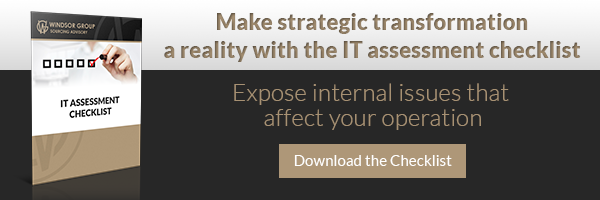 Change happens. Seemingly faster and faster, especially in the burgeoning realm of IT. Regular periodic review ensures you’re not falling behind, or inadvertently falling into an “obsolescence trap.” Reviewing your enterprise-wide IT status also points up opportunities to improve service, sometimes even develop new revenue streams. Your review will be a lot more productive if you use an IT infrastructure assessment checklist.
Change happens. Seemingly faster and faster, especially in the burgeoning realm of IT. Regular periodic review ensures you’re not falling behind, or inadvertently falling into an “obsolescence trap.” Reviewing your enterprise-wide IT status also points up opportunities to improve service, sometimes even develop new revenue streams. Your review will be a lot more productive if you use an IT infrastructure assessment checklist.
What you learn from your assessment helps top execs as well as your IT managers stay up-to-date, so thinking about and planning for change is easier and can be more strategic. And while you may need to conduct more detailed review and analysis regarding specific projects, at least you won’t be starting from scratch.
What should an IT infrastructure assessment checklist cover? In a word, everything. That way, you’ll be able to use your checklist as a comprehensive tool to conduct your review. In order to ensure your IT systems are supporting top business performance across the board, you’ll want to examine all these areas:
Protocols and procedures.
Governance and management procedures have to flex with change, including defining who’s responsible for what. Do your current policies and processes meet compliance standards? Have you implemented the latest industry best practices? Are these things well-documented, and is that documentation up-to-date?
Disaster recovery.
This is critical, which means your recovery plan should also undergo regular review and evaluation. Does it work in reality as it’s planned on paper? Does everyone know their role in the event of a localized failure or wholesale natural disaster?
Do you have applications/systems aging out of support?
It’s not just your most powerful legacy systems you have to worry about. Your IT infrastructure assessment checklist should help you review your hardware and software, both third-party and enterprise applications, to determine adequacy of storage as well as computing capability. And remember that even very large enterprises can have pockets of users still relying on equipment or products that could soon age out of the manufacturer’s support program. That can leave you dangerously vulnerable to service failures, delays or even security lapses.
The financial side.
Are contractual and other costs as expected and planned? What’s coming up in the way of upgrades or renewal, and how can you address that most cost-effectively? To accurately review each service area as well as your total cost of ownership, your IT infrastructure assessment checklist should incorporate direct and indirect expenses.
Security.
You don’t want to become the next Target, but you want to avoid small-scale security breaches because they’re more likely and can still wreak havoc.
The personal side.
Are employees and customers able to quickly and reliably access data they need, when they need it? Your IT infrastructure assessment checklist may need to include a short survey aimed at one of both of these audiences, because neglecting the human aspect of “infrastructure” can be extremely risky. No system has value unless it’s easy to use, and your company’s future depends on high morale and customer satisfaction.
Staffing.
Who’s leaving, who will be left, and what does that mean for IT and overall business functionality?
Long-term business goals.
Have any of your implementation priorities changed? How does that affect your IT needs now or in the future? And conversely, how well does your current IT configuration support those new priorities – or as-yet-unknown changes?
A knowledgeable IT consultant can help you pull all this together, so your review process goes smoothly and provides you with maximum insight. A consultant can help create a thorough IT infrastructure checklist, undertake the review itself on your behalf or collaboratively, help evaluate the findings and develop the most effective responses.
And if you’re considering outsourcing, your consultant is perfectly positioned to assist with that process, too. Thorough review is the first step, so you’ll already be on your way to building a high-level business case and effectively comparing your options.


